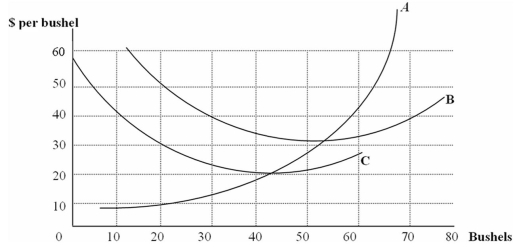A) extra benefit of the last unit produced is less than the extra cost.
B) firm should lower its output to increase profits.
C) firm is earning an average profit of $0.50.
D) extra benefit of the last unit produced is greater than the extra cost.
Correct Answer

verified
Correct Answer
verified
Multiple Choice
When some factors of production are fixed,in order to increase production by equal amounts,a firm would need to add successively:
A) smaller and smaller quantities of the variable factor.
B) constant quantities of the variable factor.
C) larger and larger quantities of the variable factor.
D) larger and larger quantities of the fixed factors.
Correct Answer

verified
Correct Answer
verified
Multiple Choice
Total revenue minus total explicit and implicit costs defines:
A) gross earnings.
B) profit.
C) marginal earnings.
D) net worth.
Correct Answer

verified
Correct Answer
verified
Multiple Choice
Assume that a firm uses 13 employee-hours and an office to produce 100 units of output.The price of output is $5,the wage rate is $10,and rent is $200.The firm will earn a _____ of _____.
A) profit;$370
B) loss;$200
C) profit;$170
D) loss;$170
Correct Answer

verified
Correct Answer
verified
Multiple Choice
This graph shows the cost functions of Moe's mushroom gathering business,which is perfectly competitive.  In the graph above,Average Variable Cost is labeled _____,Average Total Cost is labeled _____,and Marginal Cost is labeled ______.
In the graph above,Average Variable Cost is labeled _____,Average Total Cost is labeled _____,and Marginal Cost is labeled ______.
A) A;B;C
B) C;B;A
C) B;C;A
D) C;A;B
Correct Answer

verified
Correct Answer
verified
Multiple Choice
John is trying to decide how to divide his time between his job as a stocker in the local grocery store,which pays $7 per hour for as many hours as he chooses to work,and cleaning windows for the businesses downtown.He makes $2 for every window he cleans.John is indifferent between the two tasks,and the number of windows he can clean depends on how many hours he spends cleaning in a day,as shown in the table below: His benefit from the first hour cleaning windows is
A) $14.
B) $18.
C) $7.
D) $2.
Correct Answer

verified
Correct Answer
verified
Multiple Choice
According to the cost-benefit principle,you should switch to another task or job when:
A) the benefit from performing the new task is less than the benefit from continuing to perform the original task.
B) the benefit from performing the new task just exceeds the opportunity cost of performing that new task.
C) your productivity at the first task has diminished to the point at which the benefit from continuing with that task is zero.
D) the opportunity cost of performing the original task is less than the benefit of performing the original task.
Correct Answer

verified
Correct Answer
verified
Multiple Choice
What is the optimal supply of roadside litter?
A) Zero,because it is costless for each individual to throw away his or her own trash.
B) The quantity of litter that would remain if trash were picked up until the average cost of picking up trash equaled the total benefit.
C) The quantity of litter that would remain if trash were picked up until the marginal cost of picking up trash equaled the marginal benefit.
D) The quantity of litter that would remain if trash were picked up until the total cost of picking up trash equaled the marginal benefit.
Correct Answer

verified
Correct Answer
verified
Showing 101 - 108 of 108
Related Exams